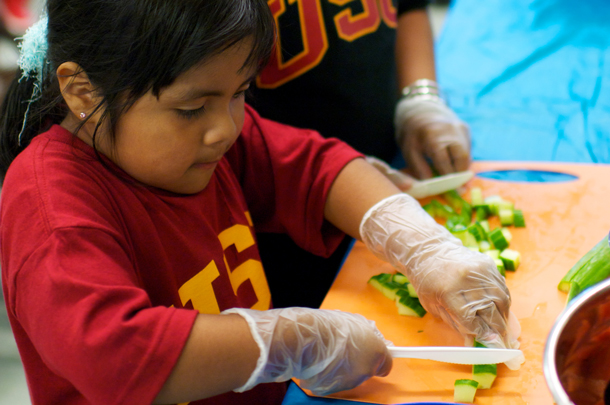When it comes to fresh fruit and veggies, East Los Angeles can be a desert of unhealthiness.
That’s why USC’s Fit Families program is an oasis of sorts in places like Boyle Heights, El Sereno and Lincoln Heights, where fast-food outlets far outnumber grocery stores.
The free health-and-wellness program every Saturday at Hazard Park educates residents — especially children — about diet and exercise. Each session ends with nutritional training nearby in the cafeteria at Keck Hospital of USC.
People who live in so-called food deserts have higher rates and risks of obesity-related chronic diseases such as heart disease, diabetes, hypertension and stroke, according to the L.A. County Department of Public Health. To support neighborhood residents, the USC Division of Biokinesiology and Physical Therapy, located in the Center for the Health Professions Building on Alcazar Street, began Fit Families in 2006.
“When we first began the program, we targeted children ages 10 to 17,” said Cheryl Resnik, DPT, associate chair and associate professor of clinical physical therapy and director of community outreach. “Since then, we extended our program to children as young as 7 to promote healthy lifestyles at an even earlier age.”
Participants range from age 7 to 54. Youngsters must be accompanied by an adult.
Each Saturday, volunteer USC physical therapists and students first record the participants’ vital signs. An exercise portion with a group warm-up is followed by circuit training and breakout activities that may include Zumba, yoga and games.
The nutritional program at the end is taught by nutritionist and health educator Sara Jean Train, who plans each week’s lesson thoughtfully to meet the needs of people living in a food desert like East L.A. Typical lessons include learning to read food labels or adding fruits and vegetables to meals. Creating a healthy diet for individuals with diabetes is also important. Afterward, the group cooks a healthy recipe using seasonal ingredients.
“My goal is to inspire people to think creatively about their food and feel empowered to make changes,” Train said. All the recipes include ingredients that can be purchased with Supplemental Nutrition Assistance Program (SNAP) cards that help low-income families afford groceries.
“The most rewarding part of all is seeing families achieve their health goals and get excited about being healthy,” Train said.
— Yasmine Pezeshkpour


